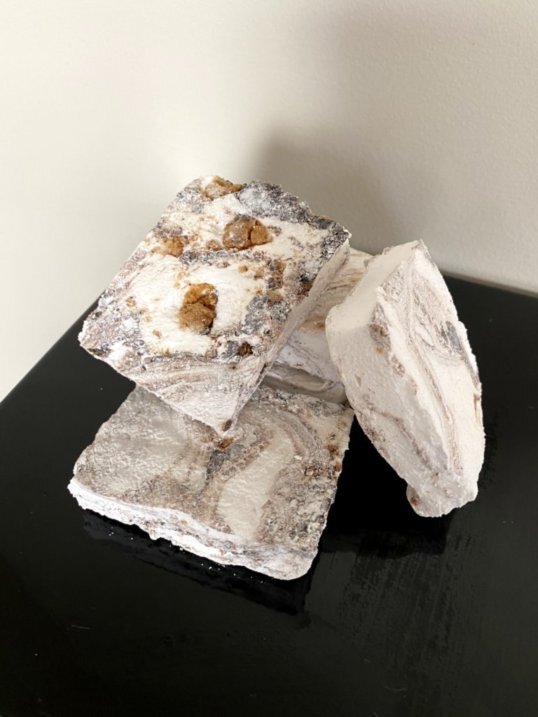Strawberry Rhubarb Jam
In pastry school, one of our classes was staffing the full service bakery and cafe. We spent three weeks in the back of the house prepping and baking at various stations and three weeks in front of the counter serving guests. It was located in the main hall on campus and was a huge draw for the families and tourists visiting. There was a huge window that gave passersby a view into the bakeshop to see the students at work, and folks used to press their noses up onto the glass like we were in a fishbowl. Because of the audience, there was an unglamorous job we used to pass around like it was a short straw- jam.
The retail section of the bakery sold so many items that we would make a huge pot of jam multiple times a week to support the demand. This required standing over a boiling vat of fruit (sometimes two at once), boosted by a step stool, wearing a black garbage bag over our chef whites to prevent splatters. It was a hot, jam facial that tourists loved to mock. I wish I had a picture now to memorialize now, but it was THAT embarrassing at the time.
That experience aside, making smaller quantities of jam is actually very easy to do, and a great way to utilize fruit before it goes bad. You can use fresh fruit, frozen fruit, mixed fruit - the options are endless and provided you understand a few key things about the process, you can apply this recipe to any flavor of jam. Before we get into the specifics, here are the things you need to keep in mind when making jam:
Viscosity- different kinds of fruit contain different amounts of water. The way you turn it into jam is by boiling off this water. ‘Undercooked’ jam is too loose because it still contains too much water.
Pectin- in addition to water, pectin is a key component of fruit that affects the final jam product. The higher the level of pectin, the quicker you’ll achieve the characteristic ‘gel’. You can also add commercial pectin or another gelling agent like cornstarch or tapioca starch to your jam as it cooks to speed up the process. On the fruit pectin spectrum, apples have high levels of pectin (in their skin) and berries for the most part have lower levels.
Heat- cooked jam is hot! It will naturally be looser when it is hot and boiling than once it is cooled and gelled. To test actual doneness, spread a drop to cool on a plate.
Sweetness- once again, this depends on the fruit. When in doubt, add less sugar at the beginning, taste, and then add more during the cooking process if needed.
Strawberry Rhubarb Jam
Ingredients:
- 1.5 c Diced Rhubarb
- 1.5c Diced Strawberries
- 3/4c Granulated Sugar
- 1/4 c Tap Water
- 1 Tbsp Orange Juice (optional)
- 1 tsp orange zest (optional)
Instructions:
- Combine all ingredients in a heavy-bottomed saucepan and stir to incorporate.
- Bring to a boil over medium heat, making sure there is enough water in the bottom of the pan so that the fruit does not burn before releasing its own juices.
- Reduce heat to low and simmer, stirring occasionally until enough water has evaporated that the mixture has started to thicken and gel.
- Test for doneness by dropping a spoonful of hot jam onto a cold plate, spread to cool. You should be able to make a track through the center that will stay when done.







